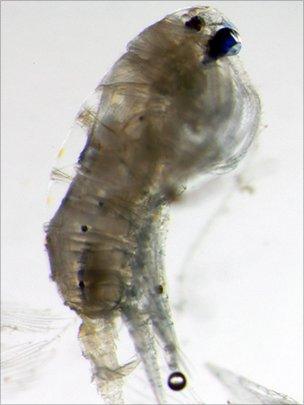'Flying plankton' escape predatory fish
- Published

Scientists studied escapes by the Anomalocera ornata copepod in the north-western Gulf of Mexico
Tiny shrimp-like creatures called copepods break through the ocean's surface and leap through the air to escape predators, US scientists say.
They have been investigating how the brightly-colouredPontellidcopepods, which live close to the surface, are so abundant yet so conspicuous to fish.
Writing inProceedings of the Royal Society B,, externalthe scientists say copepods travel further in air than in water.
Predators are also left confused about where they will land, they say.
Almost all commercially important fish, including cod, pollock and whiting, feed on copepods, a group of crustaceans made largely of species that simply drift around like plankton.
There are reports from the late-19th Century of copepods breaking through the water surface but observers at the time thought this was to allow them to moult.
A later report proposed jumping was part of an escape from predators but was not confirmed.
Dr Brad Gemmell of the University of Texas in Austin, who is behind the new study, said there had been little research on predator-prey interaction around the few millimetres below the ocean's surface, a "unique and important habitat".
He said he found it "paradoxical" thatPontellidcopepods, in particular, were so abundant yet lived where they ought to be an easy target for fish.
Unlike other species of copepods, they do not migrate down to darker waters where they can hide during daylight hours.
Instead, they stay close to the surface and are often bright blue or green to protect them from UV radiation. They are also 3mm (0.1 inches) long, larger than other species.
This, said Dr Gemmell, would suggest they should have a poor survival rate.
However, his research shows they have the ability to jump out of the water, often travelling 10 to 20 times their own body length through the air, to escape hungry fish and get out of their perspective field.
The team's calculations show copepods use up to 39% of their kinetic energy to break through the surface tension of the water. Flying fish, by comparison, use less than 0.07%.
This means copepods have to balance the risk of being eaten with the cost to their fitness by avoiding unnecessary escapes, the paper suggests.
They also have to make sure they travel far enough to avoid being chased or coming under another attack.
It is suggested in the paper that certain species of copepods may have special adaptations to make it easier for them to jump out of the water, although further investigation is needed.
One suggestion is that the body surface of jumping copepods is more resistant to water than species that stay underwater.
Another is that they are able to inject chemicals to reduce the surface tension of the water by three to six times.